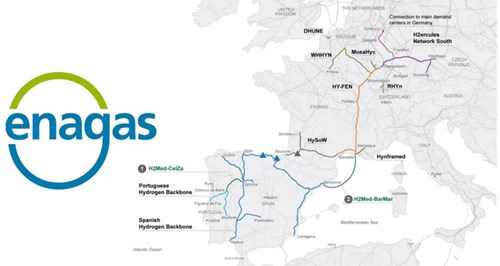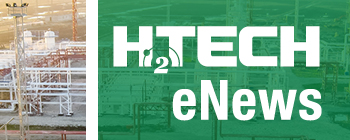News
Enagas launches PCPP for the Basque Country's Hydrogen Backbone network
- The Lehendakari (President of the Regional Government) Imanol Pradales; the Secretary of State for Energy, Joan Groizard; the Basque Government Minister for Industry, Energy Transition and Sustainability, Mikel Jauregi, and the Managing Director of Enagás, Arturo Gonzalo, have given the green light for the Public Participation Plan for this infrastructure, key to the sustainable economic development of the Basque Country, at the Port of Bilbao
Enagás launched the Public Participation Concept Plan (PCPP) for the Basque Country's Hydrogen Backbone Network at an institutional event attended by the Basque President, Imanol Pradales; the Secretary of State for Energy, Joan Groizard; the Basque Government's Minister for Industry, Energy Transition and Sustainability, Mikel Jauregi, and Enagás' CEO, Arturo Gonzalo.

The event, held this morning at the Port of Bilbao, at which the details of this project, which will be key to the sustainable economic development of the Basque Country, were presented, was attended by the mayors and councilors of the towns and cities through which the network will run, as well as representatives of the main industrial players and companies in the hydrogen value chain in the Basque Country.
The Lehendakari, Imanol Pradales, defended the need to decarbonize the Basque economic and development model as quickly as possible without losing competitiveness, given that "our employment, social cohesion, technological progress and environmental balance" and "our strategic autonomy" are at stake. During his speech, the Lehendakari pointed out that the Basque Country is taking steps to place itself at the forefront of this transformation and said that "the development of the hydrogen value chain is one of the Basque Country's strategic commitments".
"This project is perfectly aligned with this priority, as it envisages a network of around 163 kilometers of pipelines connecting the main industrial centers in the Basque Country with hydrogen production centers. This network leverages the synergies with current infrastructures, and is also complemented by other projects in the pipeline, such as the one that will connect the Ayala Valley, and the Bergara-Irun pipeline", the Lehendakari stressed. In this respect, he ratified the Basque Government's determination to actively participate in the development of this network through the Basque Energy Agency.
The Secretary of State for Energy, Joan Groizard, pointed out that "The Ministry for Ecological Transition and the Demographic Challenge, through the IDAE, has already raised more than three billion euros in funding for the development of renewable hydrogen. This commitment has already materialized in more than 100 projects, nine of them in the Basque Country, which are raising some 6 billion euros in investment. But the potential of these projects, large and small, will be realized when they are interconnected with the hydrogen backbone, which will act as the core axis of the system. This process would not be possible without the coordination between the General State Administration, the autonomous communities and Enagás, selected by the Council of Ministers as the operator of the backbone network. And the public participation process we are launching today is an essential part of that journey.
The Basque Government's Regional Minister for Industry, Energy Transition and Sustainability, Mikel Jauregi, added that "In the Basque Country we are continuing our commitment to new energy infrastructures and intelligent decarbonization, thus combining the reduction of our emissions with greater competitiveness of our industry. This new element of infrastructure will make it possible to replace gas with green hydrogen to decarbonize our industry and power generation".
Enagás CEO Arturo Gonzalo stressed that "the Basque Country is already a key energy and industrial hub in Europe and will strengthen this position thanks to its crucial role in the Hydrogen Backbone Network. Through the Public Participation Plan, town and city councils, government agencies and Basque citizens will contribute to the development of this infrastructure and decarbonization. Green hydrogen will have a very significant economic and social impact on the Basque Country".
Key location of the Hydrogen Backbone. The Basque Country, which will avail of a network of around 163 km of hydro-products within the Cantabrian Coast Axis, will have two sections: the Reocín-Arrigoriaga section, with around 38 km in Basque territory; and the Arrigoriaga-Haro section, with approximately 125 km.
The future network will turn the Basque Country into a nerve center of the hydrogen market, with a potential aggregation node in the vicinity of Bilbao and Vitoria-Gasteiz where future production and consumption projects will be clustered.
The results of the Call For Interest - submitted in 2024 - of the first axes of the Spanish Hydrogen Backbone Network that form part of the European Project of Common Interest (PCI) list, identify the Basque Country as an important location of renewable hydrogen.
This element of infrastructure will contribute to the fulfilment of the Basque Hydrogen Strategy, which envisages the production of 100,000 metric tons of green hydrogen and up to 300 MW of electrolysis per year by 2030.
The Public Participation Plan will tour 50 Basque municipalities. The PCPP, which will run until 19 December, will set up information points in 50 Basque municipalities - 30 in Bizkaia, 7 in Guipuzcoa and 13 in Araba/Álava. In Biscay: in Muskiz, Zierbena, Santurtzi, Abanto and Ciérvana-Abanto Zierbena, Ortuella, Valle de Trápaga-Trapagaran, Galdames, Barakaldo, Güeñes, Alonsotegi, Bilbao, Arrankudiaga-Zollo, Arrigorriaga, Ugao-Miraballes, Zaratamo, Zeberio, Usansolo, Bedia, Lemoa, Igorre, Amorebieta-Etxano, Dima, Durango, Iurreta, Garai, Izurtza, Abadiño, Berriz, Elorrio and Atxondo. In Guipuzcoa: in Elgeta, Bergara, Oñati, Arrasate/Mondragón, Aretxabaleta, Eskoriatza and Leintz-Gatzaga. In Araba/Álava: in Okondo, San Millán/Donemiliaga, Barrundia, Elburgo/Burgelu, Arratzua-Ubarrundia, Legutio, Zigoitia, Vitoria-Gasteiz, Iruña Oka/Iruña de Oca, Armiñón, Berantevilla, Zambrana and Labastida/Bastida. The Plan also provides for participatory workshops to be held in 18 of these localities.
Participatory open days. The Basque Country is the recipient of the largest public participation plan of its kind in Spain, which will pass through a total of 13 autonomous communities and more than 500 municipalities. Enagás launched the plan on 25 April.
The Spanish hydrogen backbone network’s PPCP will collect the inputs of the autonomous communities and the councils of the towns and cities through which it passes, the 50-plus government authorities, 380 organizations and associations and all the citizens interested in taking part. The Plan deployment is expected to take 18 months, and, once it has been completed, a final report on the results of the process will be drawn up.
The aim of the Plan is to share information on the future hydrogen network with all the stakeholders, resolve queries, explain the need for the project, foster the active participation of the communities in the process, mitigate any impacts on the ground, and guarantee the most appropriate social and environmental actions from an early stage.
The project for the first axes of the Spanish Hydrogen Backbone Network consists of the development of around 2,600 kilometers of hydroducts, grouped into 15 sections and 5 axes. The hydrogen economy will generate more than 32 billion euros of GDP in Spain and support some 81,000 jobs during the development of the Backbone Network.

